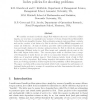Free Online Productivity Tools
i2Speak
i2Symbol
i2OCR
iTex2Img
iWeb2Print
iWeb2Shot
i2Type
iPdf2Split
iPdf2Merge
i2Bopomofo
i2Arabic
i2Style
i2Image
i2PDF
iLatex2Rtf
Sci2ools
IOR
2007
2007
Index Policies for Shooting Problems
We consider a scenario in which a single Red wishes to shoot at a collection of Blue targets, one at a time, to maximise some measure of return obtained from Blues killed before Red’s own (possible) demise. Such a situation arises in various military contexts such as the conduct of air defence by Red in the face of Blue SEAD (suppression of enemy air defences). A class of decision processes called multi-armed bandits has been previously deployed to develop optimal policies for Red in which she attaches a calibrating (Gittins) index to each Blue target and optimally shoots next at the Blue with largest index value. The current paper seeks to elucidate how a range of developments of index theory are able to accommodate features of such problems which are of practical military import. Such features include levels of risk to Red which are policy dependent, Red having imperfect information about the Blues she faces, an evolving population of Blue targets and the possibility of Red diseng...
| Added | 15 Dec 2010 |
| Updated | 15 Dec 2010 |
| Type | Journal |
| Year | 2007 |
| Where | IOR |
| Authors | Kevin D. Glazebrook, Christopher Kirkbride, H. M. Mitchell, Donald P. Gaver, Patricia A. Jacobs |
Comments (0)

